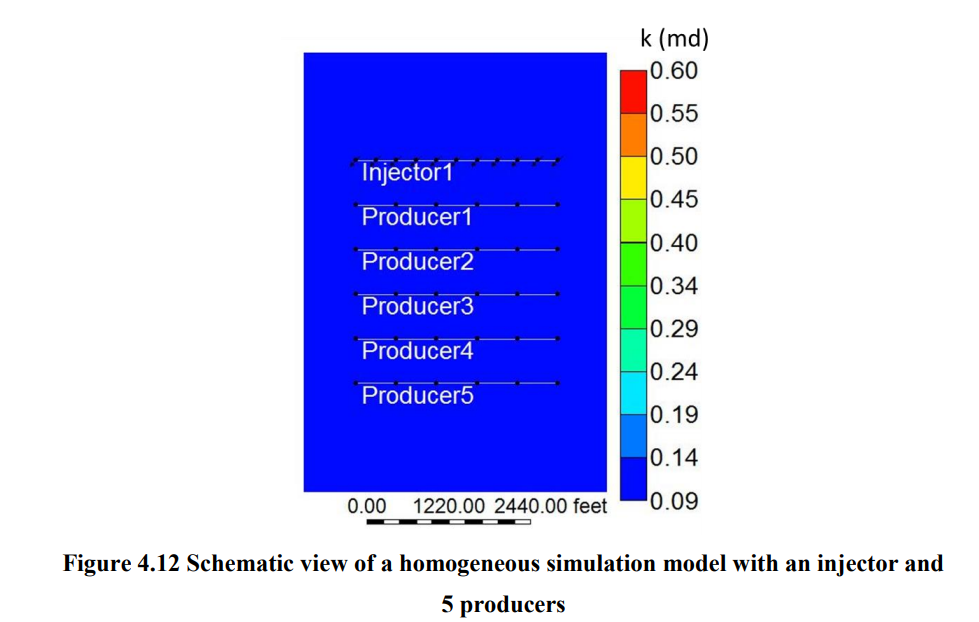致密储藏渗透率小于0.1 md,且储量可观。尽管开发这些致密储层通常采用小井距,但储层非均质性导致了不同的井间连通性。有效评估连通性可以提高模型的真实性,并充分识别地质控制范围,从而使现场管理更加可靠。 在本研究中,我们使用电容模型(CM)来评估井间连通性。为了使CM适用于致密储层,我们通过添加虚拟井(CM-PW)对模型进行了修改,将模型应用于任何感兴趣的面积区域,并模拟生产井长期瞬变过程。CM-PW在多个非均质模拟案例中进行了测试,结果表明,致密储层的计算连通性与高渗透率案例的结果一致,误差较小(<7%)。我们将CM-PW应用于East Pembina油田(Cardium组)和Forget North油田(Bakken组)的选定水驱区域。为对现有CM分析的进一步改进,现场分析中包括了水平井。 确定了East Pembina油田局部主应力和水力压裂支撑剂用量对井间连通性的影响。压裂前井间连通性与最大水平应力方向一致。我们发现连通性的变化与支撑剂使用吨数成正比。此外,还研究了砾岩层对连通性的影响。我们发现,最强的虚拟井连通性指向含砾岩区域,连通性与地层流动能力有关。最后,我们还观察到连通性与通过地质研究确定的预期砂体展布范围一致。在Forget North油田连通性研究中,我们将井间连通性与地质和地震分析相关联,发现天然裂缝密度和Lodgepole水层可能是长距离连通的原因。
Interwell Connectivity in Tight Formations
ABSTRACT
A significant amount of oil and gas are present in formations having permeability less than 0.1 md. Although these tight reservoirs typically have small well spacings, not all well pairs exhibit connectivity because of the reservoir heterogeneity. Measuring connectivity can improve model realism and identify important geological controls sufficiently that field management can be made more reliable.
In this study, we use the Capacitance Model (CM) to evaluate interwell connectivity. In order to render the CM suitable for tight reservoirs, we modified the model by adding a pseudo well (CM-PW). This modification lets us apply the model to any areal window of interest and cope with long-transient periods in the production well flow rates. The CM-PW was tested with several heterogeneous simulation cases, which revealed that calculated connectivities from the tight permeability reservoirs agreed with results from higher permeability cases with only minor errors (< 7%). We applied the CM-PW to selected waterflooded areas from the East Pembina (Cardium Formation) and the Forget North (Bakken Formation) fields. As a further improvement on the existing CM analysis, horizontal wells were included in our field analyses.
- In the East Pembina Field, we could identify the effects of net local principal stress and hydraulic fracturing proppant amounts on the interwell connectivity. Pre-stimulation interwell connectivities are consistent with the maximum horizontal stress direction. We found that a change in connectivity was directly proportional with proppant tonnage. Also, the effect of the conglomerate layer on connectivity was studied. We found that strongest pseudo well connectivities are directed to the conglomerate-bearing region and the connectivities were related to the formation flow capacity. Finally, we also observed connectivity behavior consistent with the expected sandbody extent as identified through geological studies.
- In the Forget North Field connectivity study, we correlated well-to-well connectivities with geological and seismic analyses. We found that the natural fracture intensity and the Lodgepole Formation aquifer may be causes of long distance connectivity.
It is well known that the CM evaluation is affected by the formation diffusivity. Using the analogy with heat conduction, we propose a method to determine an “area of influence” for an injection well. The method includes recognition that, in addition to the diffusivity, the injection rate frequency content affects the area size. The method was applied to determine the areal window size for the CM-PW application in tight oil reservoirs. From simulated and field applications, we observed that the interwell distance at the connectivity limit is within 3 to 5% of the interwell distance estimated from the heat conduction-based method. The modified CM allows us to extend the application to important new reservoir cases. The two field studies once again show the important role of geological features on reservoir communication. Finally, the importance of the injection rate frequency spectrum on the CM measurement opens up a new understanding of the injection well influence in reservoir performance.




